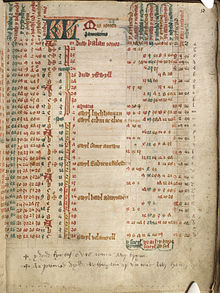Calendar of saints
The calendar of saints is the traditional Christian method of organizing a liturgical year by associating each day with one or more saints and referring to the day as the feast day or feast of said saint. The word "feast" in this context does not mean "a large meal, typically a celebratory one", but instead "an annual religious celebration, a day dedicated to a particular saint".[1]
The system arose from the early Christian custom of commemorating each
History

As the number of recognized saints increased during
The earliest feast days of saints were those of martyrs, venerated as having shown for Christ the greatest form of love, in accordance with the teaching: "Greater love has no one than this, that someone lay down his life for his friends."[4] Saint Martin of Tours is said to be the first[5][6] or at least one of the first non-martyrs to be venerated as a saint. The title "confessor" was used for such saints, who had confessed their faith in Christ by their lives rather than by their deaths. Martyrs are regarded as dying in the service of the Lord, and confessors are people who died natural deaths. A broader range of titles was used later, such as: Virgin, Pastor, Bishop, Monk, Priest, Founder, Abbot, Apostle, Doctor of the Church.
The Tridentine Missal has common formulæ for Masses of Martyrs, Confessors who were bishops, Doctors of the Church, Confessors who were not Bishops, Abbots, Virgins, Non-Virgins, Dedication of Churches, and Feast Days of the Blessed Virgin Mary. Pope Pius XII added a common formula for Popes. The 1962 Roman Missal of Pope John XXIII omitted the common of Apostles, assigning a proper Mass to every feast day of an Apostle. The present Roman Missal has common formulas for the Dedication of Churches, the Blessed Virgin Mary, Martyrs (with special formulas for missionary martyrs and virgin martyrs), pastors (subdivided into bishops, generic pastors, founders of churches, and missionaries), Doctors of the Church, Virgins, and (generic) Saints (with special formulas for abbots, monks, nuns, religious, those noted for works of mercy, educators, and [generically] women saints).
This
As different Christian jurisdictions parted ways theologically, differing lists of saints began to develop. This happened because the same individual may be considered differently by one church; in extreme examples, one church's saint may be another church's heretic, as in the cases of
Ranking of feast days
In the Catholic Church feast days are ranked in accordance with their importance. In the post-Vatican II form of the Roman Rite, feast days are ranked (in descending order of importance) as solemnities, feasts or memorials (obligatory or optional).[7] Pope John XXIII's 1960 Code of Rubrics, whose use remains authorized by the motu proprio Summorum Pontificum, divides liturgical days into I, II, III, and IV class days. Those who use even earlier forms of the Roman Rite rank feast days as doubles (of three or four kinds), Semidoubles, and Simples. See Ranking of liturgical days in the Roman Rite.
In the
The
In the
Connection to tropical cyclones
Before the advent of
This practice continued until quite some time after the
See also
- Calendar of saints (Church of England)
- Calendar of saints (Episcopal Church)
- Calendar of saints (Anglican Church of Southern Africa)
- Calendar of saints (Lutheran)
- Calendar of saints (Orthodox Tewahedo)
- Eastern Orthodox liturgical calendar
- Coptic calendar
- General Roman Calendar
- Diario Romano
- Patronal feast day
- Gŵyl Mabsant – Welsh saints' days
- List of saints
References
- ^ "feast – definition of feast in English from the Oxford dictionary". oxforddictionaries.com. Archived from the original on 27 July 2012.
- ^ "Relics and Reliquaries – Treasures of Heaven". columbia.edu. Archived from the original on 20 June 2016. Retrieved 1 August 2012.
- ^ Calendarium Romanum (Libreria Editrice Vaticana 1969), p. 89
- ^ John 15:13
- ^ "Commemoration of St. Martin of Tours". All Saints Parish. Archived from the original on 2 December 2008.
- ^ "Saint Martin of Tours". Britannica Concise Encyclopedia. 2007. Archived from the original on 2 December 2008.
- ^ "Saint Charles Borromeo Catholic Church of Picayune, MS – General Norms for the Liturgical Year and the Calendar". scborromeo.org. Archived from the original on 25 September 2014. Retrieved 13 August 2008.
- ISBN 978-1-4514-2433-1.
- ^ a b c d e f Mújica-Baker, Frank. Huracanes y tormentas que han afectado a Puerto Rico (PDF) (Report) (in Spanish). Estado Libre Asociado de Puerto Rico, Agencia Estatal para el Manejo de Emergencias y Administración de Desastres. pp. 4, 7–10, 12–14. Archived from the original (PDF) on 24 September 2015. Retrieved 12 October 2018.
- ^ "San Ciriaco Hurricane". East Carolina University, RENCI Engagement Center. Archived from the original on 19 October 2019. Retrieved 12 October 2018.
External links
- Today's Saints on the Calendar (Catholic Church)
- Greek Catholic Saints' Calendar (Greek Catholic Church) (in Ukrainian)
- Calendar of Saints (Orthodox Church in America)
- Orthodox Calendar (Ponomar Project)
- Butler's Lives of the Saints Bartleby.com
- "Selected lives, writings and devotions". ecatholic2000. Archived from the original on 14 November 2013. Retrieved 11 February 2019.
